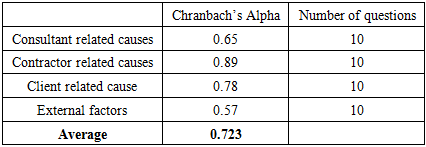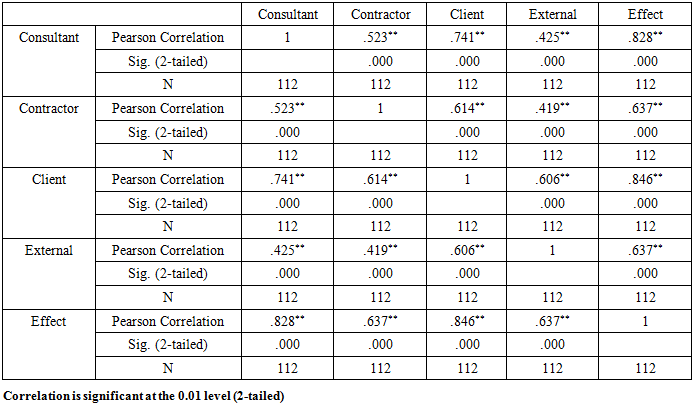-
Paper Information
- Paper Submission
-
Journal Information
- About This Journal
- Editorial Board
- Current Issue
- Archive
- Author Guidelines
- Contact Us
International Journal of Construction Engineering and Management
p-ISSN: 2326-1080 e-ISSN: 2326-1102
2020; 9(1): 11-19
doi:10.5923/j.ijcem.20200901.02

Mitigation of Building Failures in Uganda’s Construction Industry: A Case Study of Greater Bushenyi District
Lawrence Muhwezi , Dicklus Twinamatsiko , Joseph Acai
Department of Civil and Building Engineering, Kyambogo University, Kampala, Uganda
Correspondence to: Lawrence Muhwezi , Department of Civil and Building Engineering, Kyambogo University, Kampala, Uganda.
| Email: |  |
Copyright © 2020 The Author(s). Published by Scientific & Academic Publishing.
This work is licensed under the Creative Commons Attribution International License (CC BY).
http://creativecommons.org/licenses/by/4.0/

Building failures result into economic and temporal deviations in construction industry. Despite the efforts to improve the quality of construction works through use of advanced technology, increased labor force for professionals in the construction industry, increased availability of construction equipment, there is still low quality work. The purpose of the study was to develop strategies to mitigate building failures in the construction industry in Uganda. The study adopted a descriptive survey research design which was carried out in the districts of Greater Bushenyi district in Western Uganda. The study population comprised of 210 respondents: Supervising engineers, Site engineers, Site foremen, Clerk of works and Clients. Causes of building failures were categorized as: consultant related; contractor related, client related and external related factors. The data collected were analyzed quantitatively using SPSS Ver.20 and Microsoft excel. Data were further analyzed using correlation and regression analysis. Findings were presented using frequencies, tables, pie charts and graphs. The findings indicated that Inadequate supervision of works (RII= 0.77); Shortage of equipment and materials (RII=0.76); Cash flow problems (RII=0.67) and Inflation in prices (RII=0.70) were the leading causes of building failure in their respective categories. Based on study findings, it was concluded that there is a great influence of consultant related factors on the causes of building failures more particularly related with inadequate supervision of projects. Factors relating to defects in structures can potentially be avoided if qualified construction professionals are appointed to exercise due diligence and if professional teams are given the opportunity to guide contractors during contract execution.
Keywords: Building failure, Mitigation, Construction industry, Quality
Cite this paper: Lawrence Muhwezi , Dicklus Twinamatsiko , Joseph Acai , Mitigation of Building Failures in Uganda’s Construction Industry: A Case Study of Greater Bushenyi District, International Journal of Construction Engineering and Management , Vol. 9 No. 1, 2020, pp. 11-19. doi: 10.5923/j.ijcem.20200901.02.
Article Outline
1. Introduction
- The main function of the construction industry is to provide infrastructure that protects the life of users and or occupants and contents from the weather, mainly rain, wind and extremes of temperature. It is most important to provide the basic needs which will achieve all of these functions. Features such as windows, pipes, air conditioning system and finishes are only additional. Buildings for example are supposed to be structurally safe in order to survive, and the floors must be capable of resisting any normal imposed loads and this is achieved by use of good structural designs, quality materials and appropriate equipment and most importantly trained and experienced workmanship [1]. Construction failures and defects are common phenomena in construction industry and these have negative impacts towards cost, duration and resources of project. Failures and defects often cause unnecessary expenditure, deaths and project delays.Building defects can be a result of design error by the architect, a manufacturing flaw, defective materials, improper use or installation of materials, lack of adherence to the design by the contractor, or any combination of them [2]. According to [3], building failures occur due to use of sub-standard building materials, poor workmanship by contractors, use of incompetent contractors, faulty construction methodology, heavy downpour, non-compliance with specifications or standards by developers and contractors, lack of supervision, poor inspection and monitoring, structural defects, defective design/structure, illegal conversion and alterations.Residential buildings are the ones which experience most of the defects or failure problems due to poor workmanship [2]. Poor workmanship problems are closely related to the developer and also the contractor that constructs the buildings. Most defects in construction projects are due to human errors and this error happens due to poor performance in workmanship during construction [4].Despite the efforts to improve the quality of work from the construction industry through use of advanced technology, increased labor force for professionals in the construction industry, increased availability of construction equipment, there is still low rampant quality work.
2. Literature Review
2.1. Concept of Building Failure
- Building failure occurs when the building loses its ability to perform the intended (design) function. Hence, building failures can be categorized into the two broad groups of physical (structural) failures (which result in the loss of certain characteristics, e.g., strength) and performance failures (which means a reduction in function below an established acceptable limit) [5]. Structural failure corresponds to the excedance of ultimate limit state in many of the load-carrying elements, which compromise the structural stability of the building. In practice, this corresponds to extensive damage, partial or total collapse of the building, resulting in repair costs that are high relative to the replacement value of the building.
2.2. Poor Workmanship
- Poor workmanship is one of the popular factors that lead to building defects and failures problem. Residential buildings are the ones which experience most of the defects or failure problems due to poor workmanship [2] and [3]. It should be pointed out that 90% of the building failures are due to problems arising in the design and construction stages according to [1] and [2]. They add that these problems include poor communication, inadequate information or failure to check information, inadequate checks and controls, lack of technical expertise and skills, and inadequate feedback leading to recurring errors. Most defects in construction projects are due to human error and this error happens due to poor performance in workmanship during construction [4] and [2]. [6] stated that, workmanship is a manual aspect of skill. This skill would develop more with more practice and experience. In past, the quality of workmanship was excellent and it used to determine the quality of construction.
2.3. Improper Selection of Materials
- In construction industry many types of materials used are from man-made to naturally available materials such as timber, steel, plastic, brick, mortar, glass, etc. Most of the times these materials are used without any test or checks to determine whether these materials is fulfil the standard specifications or not [2] and [6]. According to [7], substandard materials especially reinforcement rods, steel sections and cement can contribute immensely to failure of buildings. Functionality in the operating environment is generally a high priority for material selection of components, especially when it comes to the long- and short-term safety and reliability of the equipment.
2.4. Un Skilled Manpower
- Most contractors working in the construction industry are beginners with low levels of construction skills and capacity to discharge their duties [2] and [4]. In most cases, local contractors who acquire construction contracts hire low skilled laborers who in turn demand less pays for labor costs hence maximizing profits. Further still, most of the site work and finishing works are subcontracted with the objective of creating job opportunities to the rural poor without qualification and proper on-the-job training and subsequently the effects are manifested by poor workmanship on the buildings. [2] and [3] recommend and suggest that as responsible professionals in the built environment, it is good for the construction companies to emphasize the need for use of qualified personnel in all construction activities as a step towards restoring sanity in the industry. According to [8], it is believed that unprofessional conducts contribution is not small measure to the menace of building collapse in Nigeria. Such unprofessional conduct like bribe collection from contractors, professional acting in the capacity beyond the scope of his profession, etc. has a negative effect indirectly on the building and may finally result into collapse of buildings.
2.5. Poor Site Supervision and Management
- According to [9], poor supervision of work and use of inferior or adulterated materials are the major causes of poor workmanship in the construction industry. Even where a structural design is not deficient, absence of proper supervision on the site by qualified personnel can lead to building failure [2] and [7]. The proper execution of the contract as per the requirements and design depends on continuous monitoring the construction process [3] and [7].
2.6. Poor Communication
- Poor communication in construction industry has been investigated extensively by many researchers and construction practitioners. Poor communication is a very important concern in the construction industry [10]. Poor communication consequently leads to cost and time overruns in the form of rework occurrence [11] and miscommunication among construction parties [12]. There are various forms of poor communication in construction industry. According to [13], lack of frequent communication among construction parties is one of the forms of poor communication. A study conducted by [14] on the impact of material delivery deviations on costs and performance in construction projects showed that quality defects and delivery deviation of materials occurred due to lack of communication among relevant parties and communication failure. Therefore, it was suggested, stakeholders have to put more concern in the enhancement of communication regularity, means and methods. Interpersonal skills which include communication skills play an important role for the success of a project [15]. Parties involved in construction possess different communication skills which also depend on their qualification and cultural background. These differences cause concurrent misunderstanding in the delivery stage [16]. In construction industry, communication is managed by channels in all the organizations hence each department or section in the organization is responsible for disseminating the related information to formulate complete communication system However, due to the complexity in construction industry several concurrent communication problems occur because no proper channeling is adopted to manage and control the communication process [17]. A study by [12] found out that that effective communication in construction is seriously hampered due to a lack of appropriate data channels, improper channel and inaccurate data transfers. [18] stated that, unclear channels of communications result in project delay. It is therefore very important to standardize the channels of communication in construction industry to fasten and ease the communication process. Dispute is a common issue that occurs in construction industry. It causes an impact on the main project components such as cost, time and quality of construction projects [19]. Dispute is commonly known as an endemic and chronic character of construction industry [20]. It was emphasized by many researchers; poor communication among construction industry is one of the main causative factors of dispute occurrence. It is, therefore, a major consequence of unsuccessful communication. [21] identified poor communication among construction parties as one of the significant causes of dispute. Lack of communication skills is considered of the utmost important diffusing factor to cause dispute in construction industry. Therefore, effective communication is very important to improve the relationship between the project team [22].
2.7. Financial Difficulty
- Projects have suffered several setbacks such as total abandonment and delays, mainly due to financial difficulties. Payment delays sometimes result in project abandonment and in some extreme circumstances; contractors go bankrupt [23]. In some circumstances, the project fails to commence after initial planning. Some projects fail because of the government’s inability to secure funds which leads to abandonment.
2.8. Foundation Failures
- According to [24] building foundation failure is attributed mostly to the nature of soil, overloading and persistent leaking of drains in that order. This may be because many residential building developers are either unaware of the need for soil investigation before construction work or see it as a needless activity.
2.9. Natural Disasters Such as Earth Quakes, Floods, Fire
- One of the major natural factors that result into building collapse is rainfall and others may include temperature and pressure [7] and [2]. [25] Identified causes of building failure as due to natural occurrences such as earthquakes, tornadoes, floods, etc. Other causes include factors such as: omission, carelessness, leading to use of deficient structural drawings, absence of proper supervision of projects, alteration of approved drawings, use of substandard materials, corruption in the Nigerian system, building without approved drawings and translocation of building plans to different sites.
2.10. Lack of Maintenance Culture
- The necessity for maintenance work on buildings is noted in the fact that all buildings, as well as the materials and components therein, deteriorate or suffer loss in aesthetic, strength and or functional value, with exposure to the elements of weather over time. The appearance and life span of a building and also the quality of the materials would be affected depending on the manner to which maintenance is adhered to, in the building [26]. If the design process is to be enhanced, the building team needs to come together and contribute towards the building’s maintainability at the project inception rather than leaving it for the maintenance personnel at the end of construction to battle with the curative measure [27]. It is often said that building defects start on the drawing board, but in some cases, they can originate at an earlier stage [23]. Inadequate brief may lay down totally unrealistic cost limits or fail to give vital information on the building. Design deficiencies could result in a building disaster if adequate attention is not to the design of bearing support, calculation errors, deformation, shrinkage problems, errors in assumed loading (especially wind), and changes in alteration of existing structures – all these could contribute substantially to building failures and disasters. [26] further stated that a skillful design can reduce the amount of maintenance work and also make it easier to perform, since good maintenance begins on the drawing board.
2.11. Impact of Building Failure in the Construction Industry in Uganda
- The consequences are usually in the form of economic and social implications [28]. These include loss of human lives, injuries, economic waste in terms of loss of properties, investments, jobs, incomes, loss of trust, dignity and exasperation of crises among the stakeholders and environmental disaster. Apart from loss of lives (mostly innocent citizens), many other people has been rendered permanent disable in one form or the other as a result of increasing rate of building collapse in the country [3] and [7].
3. Methodology
- The research design employed in this study was descriptive survey method. Descriptive design is a method of collecting data by interviewing or administering a questionnaire to sample of individuals [29]. This method is preferred because it allows for careful comparison of the research findings. It was the descriptive survey that helped to determine the causes of building failure in the construction industry. This required primary data collection on quantitative data for comparison. The study was designed to get opinions from clients, consultants and contractors of construction companies in regards to the causes, effects, as well as mitigation measures of building failures in the construction industry. The possible causes of building failures were identified from literature and these factors were tested with the stakeholders of the construction industry in the study area to seek their opinion on these causes by way of ranking them based on relative importance index (RII). Also effects of building failures were identified from literature and questionnaire was developed according to these factors to get the opinion from respondents.A quantitative approach was used to understand the perception of respondents in Greater Bushenyi district towards the factors causing building failures in the construction industry. The qualitative approach was employed to have more understanding of the phenomena.A sample size of 136 respondents was determined from the table developed by [30] where a known population of the selected respondents was 210. The respondents were drawn from a population of supervising engineers, site engineers, site foremen, clerk of works and clients from the five districts of Greater Bushenyi.Purposive and stratified sampling was used to determine the respondents but also key informants were purposively identified. A sampling frame of stakeholders in the construction industry was selected from civil servants, politicians, contractors, consultants, beneficiaries/users, and civil society organisations. In order to determine the perception of different stake holders in the construction industry regarding factors causing building failures, a questionnaire was developed. This was the main tool used to collect the data from the target respondents. The interview was also adopted as a method for data collection partly due to its cost effectiveness and its strength of capturing empirical data in both informal and formal settings. The interview guide consisted of both open and closed ended questions. Open ended questions were designed to solicit information relating to actual and expected returns on respondents and study area characteristics and their relations to building failure. Interview guide was used in the semi-structured interviews during discussions with government officials and other key informants. Unlike the questionnaire, the questions in the interview guide were open ended and emphasis was on the respondent to elaborate points. The interviewer had a list of issues which he wished to obtain answers from respondents but was flexible in terms of the order of the questions.Validity and ReliabilityBefore the detailed field survey, a pilot survey was conducted using a total of 10 respondents from Buhweju and Bushenyi districts. The pilot study was administered for the purpose of pre-testing the questionnaires to validate the relevance of the questions to the intended respondents; determining the approximate time or duration taken to fill a questionnaire with one respondent and finding out the most efficient way of carrying out main survey. Following the pilot survey some amendments were made to the questionnaires and interview guidelines, whereby questions were added, some were deleted while others were reframed to make them clearer and easier to understand.In this study, data reliability was achieved by pre-testing the questionnaire on a selected sample of three experts. Contents of the questionnaire were assesses to ascertain whether they included or represented all the content of the research in the study. A content validity index (CVI) was computed using equation (1) and was established to be 0.87 implying a reliable questionnaire was used for data collection.
 | (1) |
|
 | (2) |
 is the variance of ith item, and
is the variance of ith item, and  is the variance of the total score formed by summing all items. The results in Table 1 indicate that there is high internal consistency. This is because the Cronbach’s Alpha is high and close to one. This shows that the data used were reliable.
is the variance of the total score formed by summing all items. The results in Table 1 indicate that there is high internal consistency. This is because the Cronbach’s Alpha is high and close to one. This shows that the data used were reliable. 4. Results
- The data were analyzed according to the research objectives i.e. to establish the causes of building failures in the construction industry in Uganda and to evaluate the impact of building failure in the construction industry in Uganda.
4.1. Consultant Related Causes
- The respondents were requested to rate their opinions on the consultant related factors that affect building failure in the construction industry. The responses were measured on a five-point likert scale as: strongly disagree (1), disagree (2), not sure (3), agree (4) and strongly agree (5). This section presents the results as shown in Figure 1.
 | Figure 1. Consultant related causes of building failure in the construction industry (Source: Primary data) |
4.2. Contractor Related Causes
- The respondents were requested to rate their opinions on contractor related factors that influence building failures in the construction industry. The responses were measured on a five point Likert scale: Strongly disagree (1), disagree (2), not sure (3), Agree (4) and strongly agree (5). This section presents the outcomes of the analyses as depicted in Figure 2.
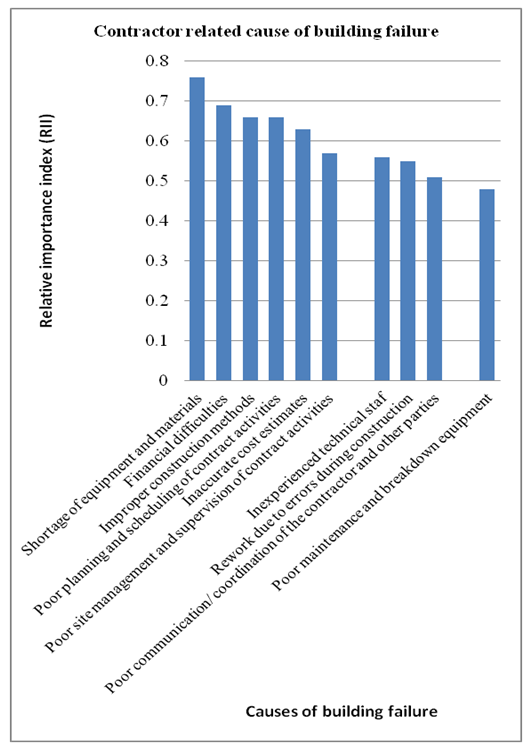 | Figure 2. Contractor related causes of building failure in the construction industry |
4.3. Client Related Causes
- The respondents were requested to give their opinions on client related causes of building failure in the construction industry. The responses were measured by a five point Likert scale; strongly disagree, disagree, Not sure, Agree and strongly agree. According to the study findings, clients’ cash flow problem was identified as the leading cause of building failure with RII=0.67. The main factor contributed by clients is when they take longer than the stipulated time in terms of the contract to certify the claim. This was followed by unavailability of incentives with RII=0.66. Slow decision making and variation of orders ranked number three with RII=0.62. Poor communication/coordination of the client and other parties ranked number nine with RII=0.52. Unrealistic contract duration ranked number 10 with RII=0.51.
 | Figure 3. Client related causes of building failure |
4.4. External Related Causes
- The respondents were asked to give their opinions on external related causes of building failure in the construction industry. The responses were measured on a five point Likert scale; strongly disagree (1), disagree (2), Not sure (3), Agree (4) and strongly agree (5). The results are presented in Figure 4. Inflation in prices ranked 1st with RII=0.70. [7] and [2] observed that the rate of inflation can cause serious problems in the economic accruals or rate of return to contractors for works undertaken, thus loss of profit. Deferring site conditions ranked second as the cause of building failure with RII=0.66. Shortage of construction materials in the market was ranked number 3 with RII=0.64. If the materials needed to carry out the project are in short supply, it will cause the project to be delayed consequently leading to failure. Acts of God was ranked number 10 with RII =0.48.
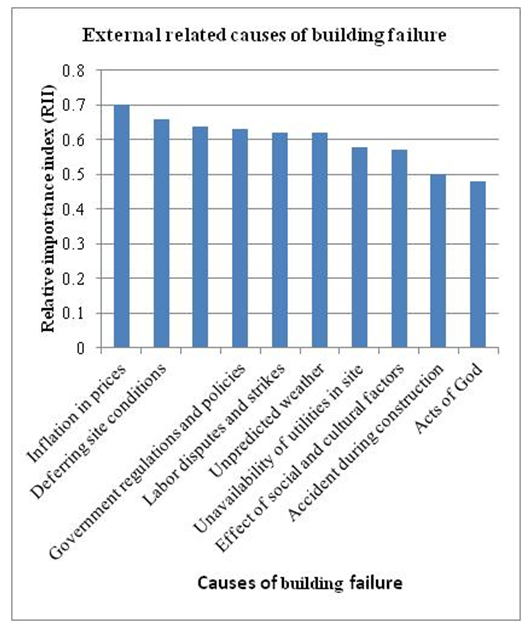 | Figure 4. External related causes of building failure (Source: primary data) |
4.5. Ranking the Overall Contribution of the Causes of Building Failures
- Descriptive statistics was run using SPSS to determine the leading contributor to the problem of building failures basing on relative importance means and the results are presented in Table 2.
|
4.6. Impact of Building Failure
- The respondents were requested to give their opinions on the impact of building failure in the construction industry. The responses were measured on a four point Likert scale; Very High (4), High (3), Low (2), Very low (1). The results are presented in Figure 5 which indicate that cracking foundation was ranked as having the leading impact of building failure with RII=0.70. Cracks may be a sign that the foundation was laid on a poorly compacted base or poorly graded soil; wide cracks could signal a foundation problem. Water leakages through the roof was ranked number two with RII=0.68. According to [33], water proofing is known as the main contributor to the failure of buildings that leads to the moisture problems. Cracks that affect the structure of the building were ranked third with RII=0.67.
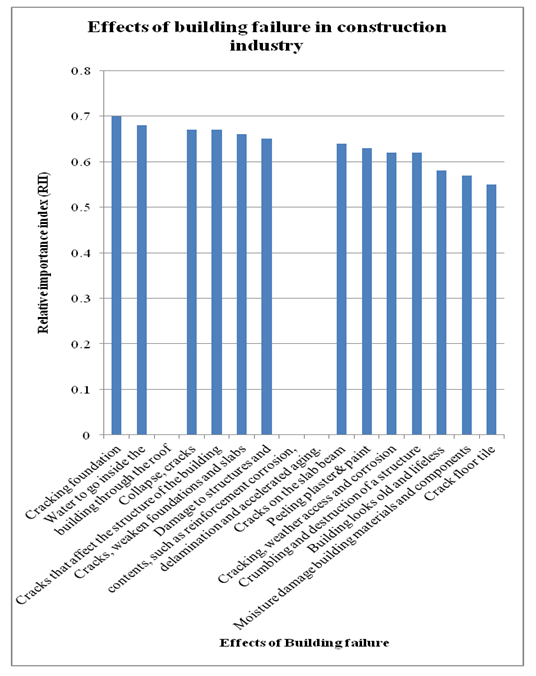 | Figure 5. Effects of building failure (Source: Primary data) |
5. Discussion and Findings
- The findings are summarized in line with the objectives of the study which were to establish the causes of building failure and to evaluate their impact on building failure in the construction industry in Uganda.
5.1. Consultant Related Causes
- The study found out that inadequate supervision of works was the leading cause of building failure with RII=0.77. This is in agreement with [1] and [4], the quality of site supervision has a major influence on the overall performance and efficiency of construction projects. Inadequate supervision is believed to be one of the major causes of rework. Respondents agreed that inadequate experience of the consultant is the second cause of building failure with RII=0.68. According to [2] and [3], lack of experiences and competency of laborers must be taken into account as a factor that contributes to poor workmanship as “productivity cannot be achieved by speed and harder work only without adopting better work practices. Conflicts between consultant and design engineer with RII=0.67, was ranked number three.
5.2. Contractor Related Causes
- Respondents agreed shortage of equipment and materials leads to building failure with RII=0.76. This is in agreement with the study by [31] and [2] where many contractors complained that they have inadequate plant and machinery and indeed often this is the case. In many instances, however, it is not so much the absence of plant which is the problem but shortage of spares, which often have to be imported, and lack of good mechanics and capable plant operators. Financial difficulties were ranked second with RII=0.69. Money or rather lack of it is probably the most discussed problem of contractors in developing countries. Contractors need relatively few fixed assets and have a low capital base compared with other industries. They should need relatively little working capital because the traditional contractual arrangements provide for payment as the project proceeds.
|
5.3. Client Related Causes
- Most respondents agreed that clients cash flow problems is major cause with RII=0.67. This was followed by unavailability of incentives with RII=0.66., Slow decision making and variation can cause serious problems in the economic accruals or rate of return to constructors for works undertaken, thus loss of profit. In the traditional orders ranked number three with RII=0.62.
5.4. External Related Causes
- Inflation in prices ranked 1st with RII=0.70. Inflation causes serious problem to contractors. Inflationary forces render submitted bids unrealistic. This has made contractors’ quantity surveyors more aware of the need to price inflationary risk at the pre-contract stage [2] and [8].
6. Mitigation Measures
- In summary, within the Ugandan construction industry, factors relating to defects can potentially be avoided if qualified professionals are appointed to exercise due diligence and if professional teams are given the opportunity to guide contractors during the contract. The cost of appointing reputable professionals in their advisory capacity has to be weighed against the cost of both social and economic constraints. The appointment of qualified construction-industry professionals to implement and maintain quality-management systems will alleviate the current problems in respect to quality of buildings within the country. The serious shortage of competent people at both local and national government level to evaluate and administer construction projects and identify contractual irregularities on all sides ultimately contributes to defective construction. The study also recommends that various relevant government agencies should allocate enough resources needed for construction of the project and monitoring and evaluation and agree on a practical arrangement to support finance the associated activities. The study further recommends that organizations should consider adopting modern information and communication technologies in carrying out monitoring and evaluation activities. Skill levels should be enhanced to meet the needs of monitoring and evaluation systems. With regard to the causes of defects, it is recommended that professionals, especially contractors, concentrate on improving or implementing an effective quality-management system. Defects must be viewed as a risk; due to the likely financial implications. The professional teams must ensure that they become more knowledgeable with regard to the effects of defects. Defects do increase the project restrictions of time and cost and affect other elements such as quality.Although not discussed in this report, corruption within Uganda’s construction industry may also contribute to irregularities with regard to procurement. The full extent of how it contributes to defects is, however, not yet clearly documented. The researcher is of the opinion that, in some circumstances, irregularities during procurement can directly be related to the appointment of incompetent contractors. However, respondents did not rate procurement-related factors as a major contributor to defective construction. This, however, might change in future, due to the large number of corrupt parties currently being exposed within the construction industry. [32] and [2] state that corruption is a pervasive stain on the construction industry in many countries, and Uganda is no exception. They also state that factors instrumental in corruption include the skills shortage within the industry, a perceived absence of deterrents and sanctions and poor ethical standards. Although the research results are limited to the views of respondents in the districts of Greater Bushenyi only, there is no reason to believe that this is not the same for the other districts of Uganda.
7. Conclusions
- Based on the study findings, it was concluded that there is a great influence of consultant related causes of building failure. The study further concluded that the quality of site supervision has a major influence on the rate of building failures and hence performance and efficiency of construction projects.The literature indicated that cracking is a frequently occurring manifestation of defects. This is confirmed, to a degree, by the empirical results from this study. Water leakages through the roof were rated as the second most frequently occurring type of defect in houses. Cracks that weaken foundations and slabs are the biggest problem and contractors spend most time rectifying cracks. Defects result from non-conformance to requirements and always result in rework. The overall causes of defects can be attributed to design, construction, material and subsurface conditions. Finally, the causes of defects lie in inadequate management or inadequate technical skills. The descriptive analysis clearly indicates that construction-related causes dominate. Quality assurance can reduce or eliminate defects by implementing quality-management systems. This, however, requires that designers, contractors and clients have the requisite skills. Procurement-related interventions may mitigate the occurrence of defects.
 Abstract
Abstract Reference
Reference Full-Text PDF
Full-Text PDF Full-text HTML
Full-text HTML